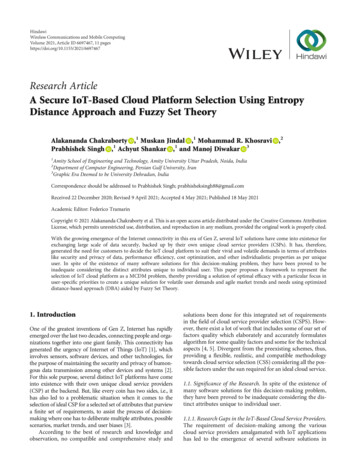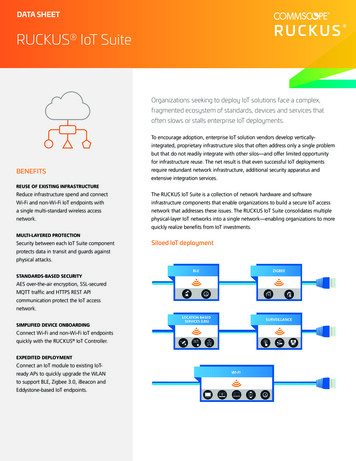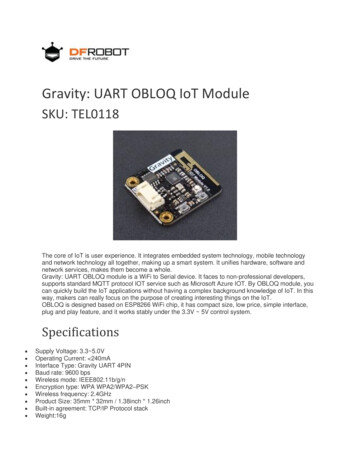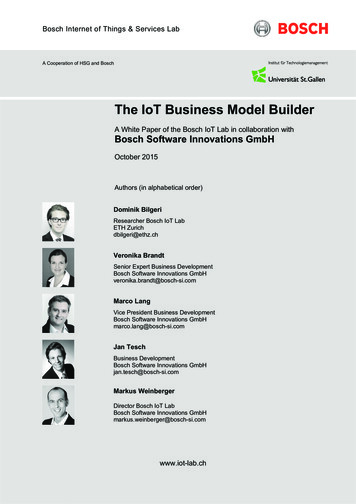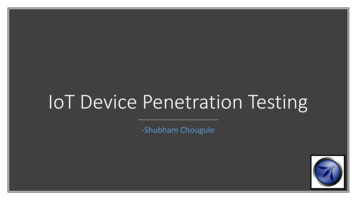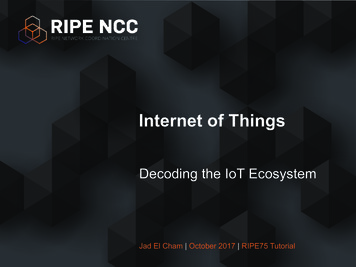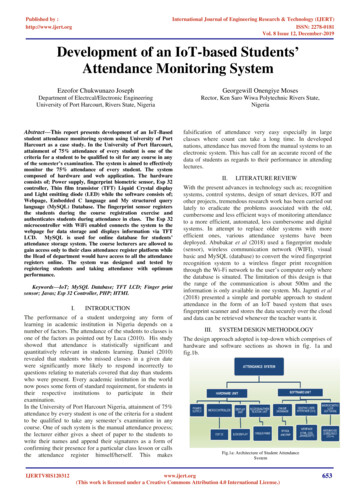
Transcription
Published by :http://www.ijert.orgInternational Journal of Engineering Research & Technology (IJERT)ISSN: 2278-0181Vol. 8 Issue 12, December-2019Development of an IoT-based Students’Attendance Monitoring SystemEzeofor Chukwunazo JosephGeorgewill Onengiye MosesDepartment of Electrcal/Electronic EngineeringUniversity of Port Harcourt, Rivers State, NigeriaRector, Ken Saro Wiwa Polytechnic Rivers State,NigeriaAbstract—This report presents development of an IoT-Basedstudent attendance monitoring system using University of PortHarcourt as a case study. In the University of Port Harcourt,attainment of 75% attendance of every student is one of thecriteria for a student to be qualified to sit for any course in anyof the semester’s examination. The system is aimed to effectivelymonitor the 75% attendance of every student. The systemcomposed of hardware and web application. The hardwareconsists of; Power supply, fingerprint biometric sensor, Esp 32controller, Thin film transistor (TFT) Liquid Crystal displayand Light emitting diode (LED) while the software consists of;Webpage, Embedded C language and My structured querylanguage (MySQL) Database. The fingerprint sensor registersthe students during the course registration exercise andauthenticates students during attendance in class. The Esp 32microcontroller with WiFi enabled connects the system to thewebpage for data storage and displays information via TFTLCD. MySQL is used for online database for students’attendance storage system. The course lecturers are allowed togain access only to their class attendance register platform whilethe Head of department would have access to all the attendanceregisters online. The system was designed and tested byregistering students and taking attendance with optimumperformance.Keywords—IoT; MySQL Database; TFT LCD; Finger printsensor; Javas; Esp 32 Controller, PHP; HTMLI.INTRODUCTIONThe performance of a student undergoing any form oflearning in academic institution in Nigeria depends on anumber of factors. The attendance of the students to classes isone of the factors as pointed out by Luca (2010). His studyshowed that attendance is statistically significant andquantitatively relevant in students learning. Daniel (2010)revealed that students who missed classes in a given datewere significantly more likely to respond incorrectly toquestions relating to materials covered that day than studentswho were present. Every academic institution in the worldnow poses some form of standard requirement, for students intheir respective institutions to participate in theirexamination.In the University of Port Harcourt Nigeria, attainment of 75%attendance by every student is one of the criteria for a studentto be qualified to take any semester’s examination in anycourse. One of such system is the manual attendance process;the lecturer either gives a sheet of paper to the students towrite their names and append their signatures as a form ofconfirming their presence for a particular class lesson or callsthe attendance register himself/herself. This makesIJERTV8IS120312falsification of attendance very easy especially in largeclasses where count can take a long time. In developednations, attendance has moved from the manual systems to anelectronic system. This has call for an accurate record of thedata of students as regards to their performance in attendinglectures.II.LITERATURE REVIEWWith the present advances in technology such as; recognitionsystems, control systems, design of smart devices, IOT andother projects, tremendous research work has been carried outlately to eradicate the problems associated with the old,cumbersome and less efficient ways of monitoring attendanceto a more efficient, automated, less cumbersome and digitalsystems. In attempt to replace older systems with moreefficient ones, various attendance systems have beendeployed. Abubakar et al (2018) used a fingerprint module(sensor), wireless communication network (WIFI), visualbasic and MySQL (database) to convert the wired fingerprintrecognition system to a wireless finger print recognitionthrough the Wi-Fi network to the user’s computer only wherethe database is situated. The limitation of this design is thatthe range of the communication is about 500m and theinformation is only available in one system. Ms. Jagruti et al(2018) presented a simple and portable approach to studentattendance in the form of an IoT based system that usesfingerprint scanner and stores the data securely over the cloudand data can be retrieved whenever the teacher wants it.III.SYSTEM DESIGN METHODOLOGYThe design approach adopted is top-down which comprises ofhardware and software sections as shown in fig. 1a andfig.1b.Fig.1a: Architecture of Student AttendanceSystemwww.ijert.org(This work is licensed under a Creative Commons Attribution 4.0 International License.)653
Published by :http://www.ijert.orgInternational Journal of Engineering Research & Technology (IJERT)ISSN: 2278-0181Vol. 8 Issue 12, December-20194) Finger Print Sensor: The commonest form ofbiometric identification is the use of fingerprint sensor shownin fig. 4. This particular fingerprint sensor is emplyedbecause it is easy to use and also comes with fairly straightforward Arduino library to enable its functionality and easytesting.Fig.1.1b: System block diagramA. Harware section of the SystemThe hardware unit of the system composed of power supply,microcontroller-Esp 32, Thin Film Transistor (TFT) Liquidcrystal displays (LCD), and finger print sensor. Each of theunits is described as follows:1) Power supply: The system requires 5 DC voltage forits optimium performance. The 5 DC voltage is captured byconnecting (step-down transformer, bridge diodes, capacitor,regulator) together.2) Esp 32 Microcontroller (fig.2): is an IoTmicrocontroller with a single 2.4 GHz WI-Fi-and-Bluetoothcombo chip designed with ultra-low-power 40 nmtechnologies. It can also be used for electronic wearable.Fig. 4: Finger print sensorThe system hardware components are connected as shown infig.5.FingerPrintTFTLCDFig. 2: Esp 32 Microcontroller of the system3) Thin Film Transistor (TFT) LCD: is a variant of LCDdisplay that uses thin film transistor technology instead oflight modulating properties of crystals to display images. It isused in appliances such as television and mobile phones etc.which do not emit light directly, instead using a backlight orreflector. TFF LCD was developed by Paul K. Weimer usingMOSFET technology and comes in different sizes andcolours as shown in fig. 3.Fig. 3: TFT LCDIJERTV8IS120312Fig. 5: System circuit diagramB. Software section of the SystemTwo major computer languages were used to develop theprograms that control the microcontroller and online webportals.1) Embedded C language: was used to program Esp 32microcontroller to allow all the hardware components to workefficiently.2) Web portals development: this is the interface whereusers interact with the system to either get data from thesystem or store data in the system. The webpages for thestudent’s attendance management system are designed usingHTML (for the structure), CSS (to style the web pages), andJavaScript (to add functionality of the webpage).3) Online DataBase: MySQL is an open source relationaldatabase management system (RDBMS) for storing studentattendance record in the cloud. PHP is also a general-www.ijert.org(This work is licensed under a Creative Commons Attribution 4.0 International License.)654
Published by :http://www.ijert.orgInternational Journal of Engineering Research & Technology (IJERT)ISSN: 2278-0181Vol. 8 Issue 12, December-2019purposed programming language originally designed for webdevelopment used to receive data from the client side,manipulate data to be stored and transfer the data to MySQLdatabase for storage.C. System Algorithm and Flow ChartDifferent algorithms and flow charts were generated. Thealgorithm for students and lecturers’ online registrationprocess is shown below.1) Stuudents Finger Print Registration: The algorithm forfingerprint registration process for both the lecturers and thestudents are written below Start. Initialize the system. Is a human finger on the sensor interface? Yes: Scan the finger. No: Go to step 3. Is scan is ok? No: Go to step 3. Yes: Is D4 1? Yes: The system Creates Model. The system stores the fingerprint model created. No: the system search database for a match. Is match found? Yes: send to database online. No: Go To step 8The flow chart for students and lecturer’s registrationprocess is shown in fig. 6.2) Online and Database System: The algorithm for onlineand database is shown below StartLogin to websiteIs lecturer registered? No, click lecturer register;Yes, store data to database;Else if not registered, return to step 3.If student and not registered, click students register.If registered, save data to database;Else if not registered, return to step 6.Else if, lecturer and registered, click login;Input login details and click login button.View attendance for any course of interestEndThe flow chart for online and database system is shown infig. 7.Fig. 7: Flow chart for online and database systemFig. 6: Flow chart for students and lecturer’s registration processIJERTV8IS120312www.ijert.org(This work is licensed under a Creative Commons Attribution 4.0 International License.)655
Published by :http://www.ijert.orgIV.International Journal of Engineering Research & Technology (IJERT)ISSN: 2278-0181Vol. 8 Issue 12, December-2019RESULT & DISCUSSIONfrom the sketch was printed in the TFT modulesuccessfully as shown in fig.10.Various tests were conducted in Arduino IDE to ensure thatthe system hardware and software are working perfectly.1) Hardware Test: Different hardware components weretested during the system implementation stages. Microcontroller Esp 32 Test: Flash memory (fig.8) was checked by uploading a program. The WiFiwas also checked by uploading connectivityprogram using router’s network credentials.Fig.10: TFT LCD testFig. 8: Esp 32 Microcontroller flash memory test Finger Print Sensor Test: datasheet of thefingerprint sensor was used to check its pinconfiguration, power requirements and connectionestablished using UART cable. The Finger PrintManager (FPM) library downloaded from github andscan print program uploaded and tested as shown infig.9.Fig.9: Finger print program test TFT LCD Test: the pin configuration of the TFTLCD was confirmed using datasheet. TFT.h librarywas downloaded from Github and loaded in theArduino IDE. The module was interfaced with themicrocontroller and a sketch was uploaded to theESP 32 microcontroller. After the upload, messageIJERTV8IS1203122) Esp 32 Microcontroller program Test: the codes thatcontrols the entire system was written using embedded Clanguage. The Arduino IDE is a program developmentenvironment where the embedded C program for finger printcapture was written. The written codes are shown hereStart:Print (“Students biometric Registration”);While (finger no finger) {// whilefinger is not placed on the sensorPrint (“Please place valid finger”); // PrintmessageIf (finger finger present) {// if now placed on the sensorFinger1 read (valid finger);// capture fingerprint}}While (finger no finger) {// whilethe finger is not placed on the sensorPrint (“place valid finger again”);//print messageIf (finger finger present) {// if now placed on the sensorFinger2 read (valid finger);// capture fingerprint}}If (Finger1 Finger2) {//comparefingerprints for featuresStore (Finger1, 1);// store fingerprint in the print database with ID 1}End:Where: // comment3) Software Test: various program codes written usingdifferent computer languages were tested during the systemimplementation stages as detailed below: Web Pages Test: Notepad was used to testHTML, PHP and JAVASCRIPT written codes foronline web pages. The htdocs folder stores all thewww.ijert.org(This work is licensed under a Creative Commons Attribution 4.0 International License.)656
Published by :http://www.ijert.orgInternational Journal of Engineering Research & Technology (IJERT)ISSN: 2278-0181Vol. 8 Issue 12, December-2019files and programs for the web pages. The loginplatform (fig.11a) is used by the lecturer and Headof Department (HOD) to register and check studentsthat attended lecture in any course.Percentage performance platform (fig.11d) is used by thecourse lecturers to check and view the percentage of studentsthat qualify to take exam in any semester. University of PortHarcourt uses 75% attendance to permit students to writesemester’s examination.Fig.11a: Login platformStudent’s registration platform (fig.11b) is used to registerstudents into the system for storage and can be accessed bythe lecturers and HOD remotely.Fig.11d: Percentage performance platform Database Test: database and tables were createdand tested by inputting students’ matriculationnumbers into the database and view usingphpMyAdmin (fig.12). After testing, the databasewas linked with the webpages created to create thefinished websites.Fig.11b: Student’s Registration Platform platformAttendance record platform (fig.11c) is used by the courselecturer to view the registered students in his/her courses andalso those students that attended his/her classes.Fig.12: Database test using phpMyAdmin4) System Packaging: After interfacing the Fingerprint,TFT LCD and switch to the ESP 32 microcontroller on theStrip board, the circuit is enclosed inside the PVC joint boxused for the packaging. The interior view of the hardware isas shown in fig.13a and the exterior view of the system isshown in fig.13b.Fig.11c: Attendance record platformFig.13a: Interior view of the Finger print system Finger systemIJERTV8IS120312www.ijert.org(This work is licensed under a Creative Commons Attribution 4.0 International License.)657
Published by :http://www.ijert.orgInternational Journal of Engineering Research & Technology (IJERT)ISSN: 2278-0181Vol. 8 Issue 12, December-2019REFERENCESA. I. Abubakar, P. K. Kpochi and J.S. Eiyike, “Design andimplementation of a smart attendance register”, International Journalof Advance Engineering and Research Development, Vol. 5 issue 2.2018.[2]F. Akter, A.B. Akhi, N.J. Farin, Md.M. Khondoker and Md.G.Saklayen, “IoTSAMS: a novel framework for Internet of Things (IoT)Based Smart Attendance Management System”, Intelligent 236/Ica.2018.93006[3]R. Hasaneind, S. A. Nabeel, F. Ali Al, A. Basheer and A. Haider,“Attendance and information system using RFID and web-basedapplication for academic sector”, International Journal of AdvancedComputer Science and Applications, Vol. 9, issue 1, 2018.[4]J. Sonalisatyarupa and M. Akankshya, “IoT based distributedattendance system”, International Journal of Scientific & EngineeringResearch Vol. 9, issue 4, 2018, http://www.ijser.org.[5]M. Olagunju, A. E. Adeniyi and T. O. Oladele , “Staff attendancemonitoring system using fingerprint biometrics”, International JournalOf Computer Applications, Vol. 179, issue 21, 2018.[6]K. K. Md. Abdul, A. S. Towqir, Z. K. Abdullah, R. Mahbubur and S.A. Mohammad, “A paper titled: a portable and less time consumingwireless biometric attendance system for academic purpose usingNodemcu microcontroller”, 21st International Conference ofComputer and Information Technology (ICCIT), pp. 21-23, 2018.[7]P. Anilkumar, M. Akash, S. Sonica, “Iot Based Attendance System”,International Research Journal of Engineering and Technology(IRJET), Vol. 4, issue 2, 2017, www.Irjet.net.[8]H. K. Arfinsayyed, K. Khubalb, A. Shumala, “Fingerprint basedattendance system using IoT”, International Journal of AdvancedComputer Science and Applications, Vol. 9, issue 1, 2017.[9]K. Devendra, S. S. Yadav, P. Shashank and M. Pragyan, “Fingerprintbased attendance system using microcontroller and LABVIEW”,International Journal of Advanced Research in Electrical, Electronicsand Instrumentation Engineering. Vol. 4, issue 6, 2015.[10] J. R. Ms. Jagruti, A. Ms. Snehal, K. P. Rahul and R. G. Ms. Ashwini,“IoT Based Biometric Attendance System”, Journal of Science andEngineering, Vol. 2, Issue 4, 2018.[11] S. Luca, “The effect of attendance on academic performance. Paneldata evidence for introducing micro economics”, Journal of EconomicEducation, 2010.[12] R. M. Daniel, “Research in economic education: absenteeism andundergraduate exam performance”, Journal of Economic Education,Vol. 32, issue 2, 2010.[1]Fig.13b: Exterior view of the Finger print system Finger systemV.CONCLUSIONThe IoT based student attendance monitoring systemprovides a reliable data management and storage system formonitoring the attendance performance of students. Thissystem can also help shape student’s attitude to learning.Since the aim of the University educational system is to trainand educate students in character and learning, this workwould help University checkmate students during learningperiod. Using Optical fingerprint and Esp 32 IoTmicrocontroller, the student’s attendance is recorded and sentto the online database which can be retrieved by the lecturersand HODs when the need arises. The system is designed toassists the University to promote excellence and makedecisions pertaining student’s performance in attendingclasses and siting for examination. This system adopts Wi-Ficommunication technology and protocol that enables itcommunicates with smart devices such as androidsmartphones, personal computers etc. It also aimed atproviding help to the goal of the institution by monitoring andkeeping proper records of the attendance of the students, storedata online and ease in calculating the percentage attendanceof student to ascertain if a student met the standardrequirement before entering examination hall. This would aidUniversity of Port Harcourt to trace students that are qualifiedto sit for any examination and sanction those not qualified.IJERTV8IS120312www.ijert.org(This work is licensed under a Creative Commons Attribution 4.0 International License.)658
student attendance monitoring system using University of Port Harcourt as a case study. In the University of Port Harcourt, attainment of 75% attendance of every student is one of the criteria for a student to be qualified to sit for any course in any of the semester's examination. The system is aimed to effectively
